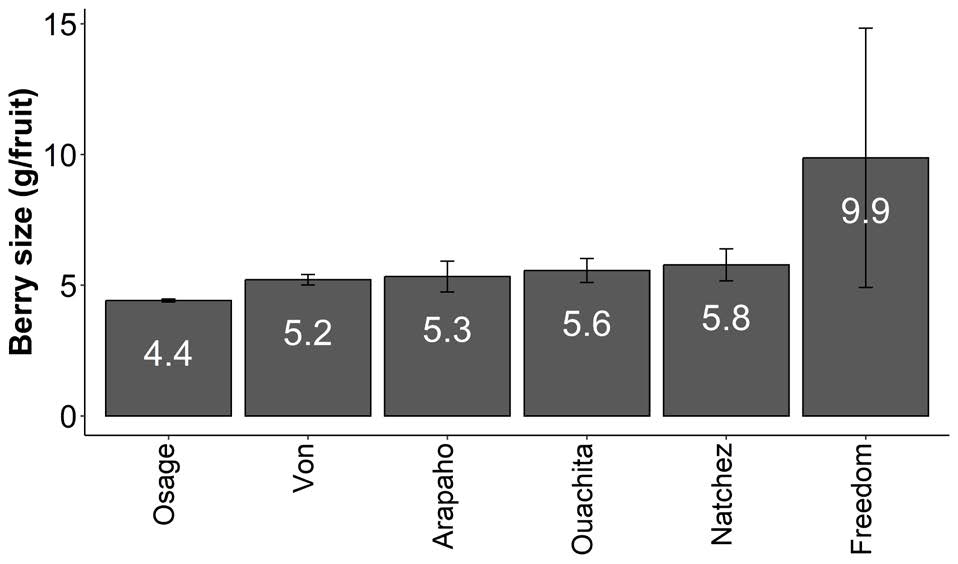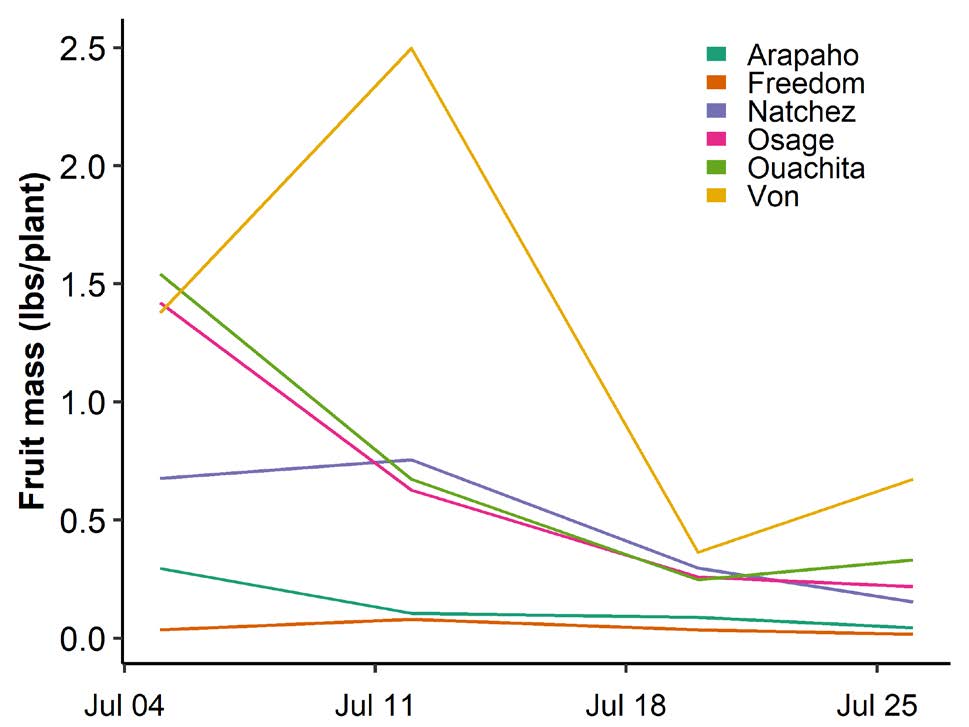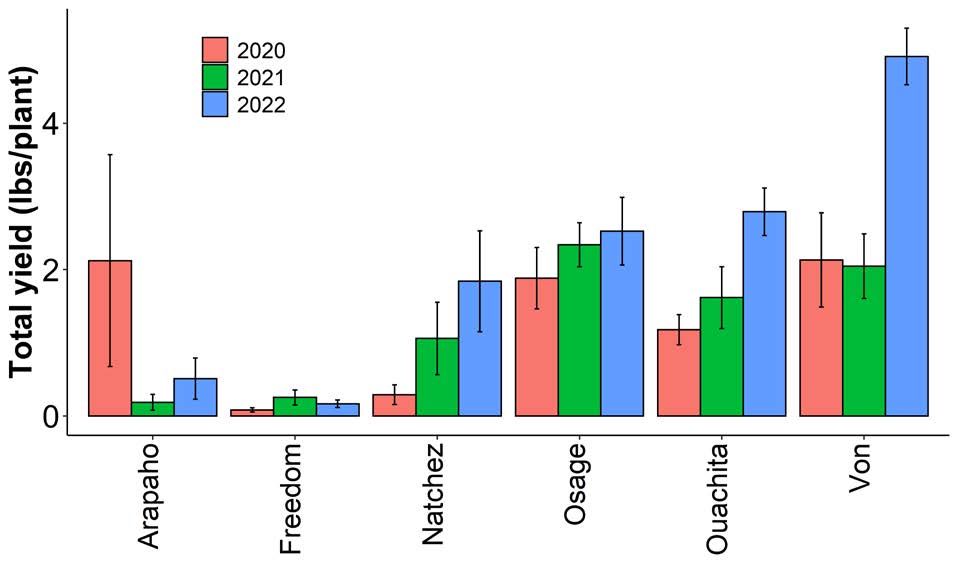Performance of Blackberry Varieties in Southern MD
Alan Leslie

Blackberries are a crop that holds potential for diversified fruit and vegetable operations in the Mid-Atlantic, with options for pick-your-own, direct
sale, or wholesale outlets. In general, blackberries are well adapted to growing conditions throughout the Mid-Atlantic, but newer variety releases from state breeding programs in Arkansas and North Carolina have yet to be thoroughly tested in this area. This variety trial was established in 2018 to test six newer varieties at the Central Maryland Research and Education Center in Upper Marlboro, MD. Varieties include Arapaho, Freedom, Natchez, Osage, Ouachita, and Von.
All varieties are thornless, floricane-fruiting types, with the exception of Freedom, which is a thornless, primocane-fruiting variety. For this trial, Freedom was managed as a floricanebearing plant, since this variety is advertised as providing both types of harvests. Floricane varieties produce fruit much earlier than primocane plants, and so one objective of this study was to determine whether these varieties produce fruit early enough in the season to overlap with or compliment the season of Junebearing strawberry production, which has been a staple crop for you-pick operations in Southern MD.

This trial included four replicates of each variety planted in a randomized complete block design. Each replicate contained three plants of that specific cultivar, each spaced 3 feet apart. For the initial two years, data were collected on plant vigor and survival, with 2020 being the first year that yield data were collected. Fertilizers and protective fungicides were applied according to production guide recommendations. Weeds were controlled with herbicide application in early summer and mowing between trellised rows. Primocanes were tipped midsummer to produce a plant height of around 7’. Spent floricanes were removed and new shoots were pruned in late winter ahead of the growing season.
Yield was measured weekly over the course of four weeks, where all ripe fruit were collected and weighed for each replicate plot. A subsample of fruit was also weighed and counted to produce a measure of the average berry size. The harvest period was initiated when there was enough ripe fruit to support you-pick clientele, and was terminated when ripe berries became scarce.

For the 2022 season, the first harvest was on July 5 and the final harvest on July 26. In total, most varieties produced more fruit per plant in 2022 compared to previous years, following a three-year trend of higher yield. Natchez, Osage, and Ouachita all had yields between 2-3 lbs/plant, while Von averaged 4.9 lbs/plant. Freedom had the lowest yield at 0.2 lbs/plant, while Arapaho produced only 0.5 lbs/plant. Results from this third year of evaluation point to Natchez, Osage, Ouachita, and Von as being recommended varieties for local blackberry production in MD, but that the relatively late fruit production will not likely fill the void left at the end of June-bearing strawberry season for you-pick operations.
 English
English العربية
العربية Български
Български 简体中文
简体中文 繁體中文
繁體中文 Hrvatski
Hrvatski Čeština
Čeština Dansk
Dansk Nederlands
Nederlands Suomi
Suomi Français
Français Deutsch
Deutsch Ελληνικά
Ελληνικά हिन्दी
हिन्दी Italiano
Italiano 日本語
日本語 한국어
한국어 Norsk bokmål
Norsk bokmål Polski
Polski Português
Português Română
Română Русский
Русский Español
Español Svenska
Svenska Català
Català Filipino
Filipino עִבְרִית
עִבְרִית Bahasa Indonesia
Bahasa Indonesia Latviešu valoda
Latviešu valoda Lietuvių kalba
Lietuvių kalba Српски језик
Српски језик Slovenčina
Slovenčina Slovenščina
Slovenščina Українська
Українська Tiếng Việt
Tiếng Việt Shqip
Shqip Eesti
Eesti Galego
Galego Magyar
Magyar Maltese
Maltese ไทย
ไทย Türkçe
Türkçe فارسی
فارسی Afrikaans
Afrikaans Bahasa Melayu
Bahasa Melayu Kiswahili
Kiswahili Gaeilge
Gaeilge Cymraeg
Cymraeg Беларуская мова
Беларуская мова Íslenska
Íslenska Македонски јазик
Македонски јазик יידיש
יידיש Հայերեն
Հայերեն Azərbaycan dili
Azərbaycan dili Euskara
Euskara ქართული
ქართული Kreyol ayisyen
Kreyol ayisyen اردو
اردو বাংলা
বাংলা Bosanski
Bosanski Cebuano
Cebuano Esperanto
Esperanto ગુજરાતી
ગુજરાતી Harshen Hausa
Harshen Hausa Hmong
Hmong Igbo
Igbo Basa Jawa
Basa Jawa ಕನ್ನಡ
ಕನ್ನಡ ភាសាខ្មែរ
ភាសាខ្មែរ ພາສາລາວ
ພາສາລາວ Latin
Latin Te Reo Māori
Te Reo Māori मराठी
मराठी Монгол
Монгол नेपाली
नेपाली ਪੰਜਾਬੀ
ਪੰਜਾਬੀ Afsoomaali
Afsoomaali தமிழ்
தமிழ் తెలుగు
తెలుగు Yorùbá
Yorùbá Zulu
Zulu ဗမာစာ
ဗမာစာ Chichewa
Chichewa Қазақ тілі
Қазақ тілі Malagasy
Malagasy മലയാളം
മലയാളം සිංහල
සිංහල Sesotho
Sesotho Basa Sunda
Basa Sunda Тоҷикӣ
Тоҷикӣ O‘zbekcha
O‘zbekcha አማርኛ
አማርኛ Corsu
Corsu Ōlelo Hawaiʻi
Ōlelo Hawaiʻi كوردی
كوردی Кыргызча
Кыргызча Lëtzebuergesch
Lëtzebuergesch پښتو
پښتو Samoan
Samoan Gàidhlig
Gàidhlig Shona
Shona سنڌي
سنڌي Frysk
Frysk isiXhosa
isiXhosa